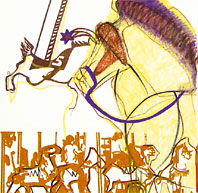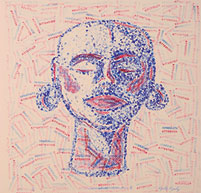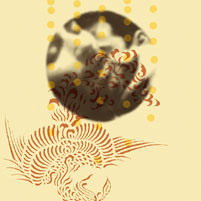
PRINTMAKING SOCIETY, SINGAPORE
Source: Marianne Teo
Marianne Teo is a freelance writer and curator. She graduated with a MA in Museum Studies from the University College, London, and was a curator with the then Singapore National Museum and NUS Museum.
Time Phase Print
Written by Marianne Teo
To mark its 25th Anniversary, The Printmaking Society (Singapore) is holding the
exhibition, Time Phase Print, as well as a series of workshops and talks.
Sixteen members are participating in this exhibition together with several
invited artists. The title aptly sums up the Society's strategy to advance
printmaking as an art form as it reaches another milestone.

Sunday Pop Over, 2005
Nur Ain, 20 x 20 cm, Silkscreen, drawing, collage,
stitching on paper
Founded in 1980 as the Contemporary Printmaking Association by Tan Ping Chiang,
Ho Ho Ying, Thang Kiang How and Wee Beng Chong from the Art Society to promote
the art of printmaking, the name was changed in 1998 to the Printmaking Society
(Singapore). Over the years it has held regular exhibitions to display the works
of printmakers. In tandem with exhibitions, it has also organised talks and
demonstrations, while some of its members teach this art form at local art
institutions. However, prior to its founding, the printmaking scene was a quiet
one and printmaking was not offered in the art schools until the mid-eighties.
Yet printmaking has enjoyed a long history in Singapore; woodblock prints
appeared as illustrations in the local Chinese newspapers in the 1930s. It was a
medium brought here by Chinese immigrant artists. This medium was widely
exploited for illustrations in books and magazines. The turning point came in
the post-war period when artists found an ideal subject for woodblock; the
subject was the social ills that came to the fore in Singapore in the 1950s and
1960s. The heyday for printmaking was during this period and artists like Lim Mu
Hue, Foo Chee San and See Cheen Tee produced powerful images that captured the
milieu of that time. Such works were displayed in the 1998 exhibition, History
through Prints: Woodblock Prints in Singapore, organized by the Society and the
Singapore History Museum. This exhibition highlighted both the medium and the
works, and demonstrated to great effect what simple tools could achieve under
the creative hands of the artists.
Today, printmaking in Singapore is challenged by the availability of the
different facilities and materials, and the lure of newer more 'exciting'
mediums. The works in this exhibition will however, hold the visitor's attention
with their detail and the personal touch of the artists.

Gods of Time / Immediate Attention II
Kelly Reedy, 50 x 50 cm
monoprint on paper
There are four parts to the exhibition. First is the striking 'patchwork' of the
participating artists' works. Each artist contributed three prints to this
fusion of cleverly collated work. The artists did not know how the final
composition would work out; the conditions they had to observe were a specific
set of colours, the use of a specific type of paper, the dimensions and the
bleeding of the edges. Once the prints were placed in position, another
technique was used to print images over this composition. Thus, in this
composite work, the different phases in the different techniques in the printing
process were creatively fused into a dazzling large composition - a fitting
metaphor for the efforts of the Society in promoting the appreciation and the
art of printmaking.
The second interesting part of the exhibition is the Book of Prints. Each artist
contributed a minimum of three prints which were then bound into a book format
measuring 50cm by 70cm. This will take visitors back in time to the past, when
prints were book illustrations. The images were painstakingly etched on wood,
stone or metal plates and printed in the printing workshops. In leafing through
these prints, visitors can also take a closer look at the prints and see the
creative features of the different printing techniques. Some will evoke a
contemplative mood while others will challenge the viewer to think about how the
prints came into being. It will be a rare visual and tactile treat to leaf
through this Book of Prints.

140 degree moment, 2005
Ernest Chan
Monotype, stenciling on paper
The third segment of the exhibition will offer a visual treat to the visitors.
Here, the prints are mounted individually and the visitor can enjoy each work in
its own space. The range of techniques used is indicative of the march of
progress from the Society's early years. The bold dramatic woodcuts contrast
with the muted, rather whimsical silkscreen and collagraph prints. Visitors will
also be treated to works by Chng Seok Tin, the doyen of the printmaking
fraternity. An artist, a teacher and a mentor, she has worked tirelessly in
pursuit of pushing the limits of the medium and the technique. Her works in this
exhibition show the versatility of printmaking and the level of maturity in this
art form.
The final section brings the visitor to the origins of the prints - the plates
from which the prints were pulled off. The plates range from wood to metal to
silkscreen. Wood, readily available, has been popular with artists like Lim Mu
Hue. A plank of wood is patiently carved to reveal the desired image in relief.
The raised image is inked with a sticky ink which does not flow into the
grooves. The paper is then pressed onto the inked block to lift the inked image.
This relief printing process is the same for images worked on metal plates. The
antithesis to the relief printing process is intaglio, where the image is
recessed into the plate and the ink is forced into the grooves or pits. The
paper is then pressed onto the plate to lift the image off the grooves or pits.
Moving away from carving or engraving on a plate is the method of silkscreen
printing. Here a stencil, cut into the desired image, is affixed to a fine mesh
of silk and the ink is forced through this onto the paper below the screen. The
plates invite the visitor to pause and ponder the various processes of
printmaking.
The organisation of the works in this exhibition serve to inform the lay visitor
of the creative printmaking process and the results of this process. For fellow
artists, the exhibition is a platform for sharing of ideas and the re-thinking
of one's art and art making. In the attendant activities organised by the
Society, the printmaking medium will be put forth for discussion and creative
innovations will be bared for scrutiny and debate. Time Phase Print is thus a
timely platform to bring the Society to a new level of communication within the
printmaking community and the public at large.

Forest Queen, 2005
Susanne Ramberg, 50 x 50 cm
Silkscreen on paper